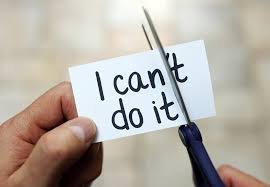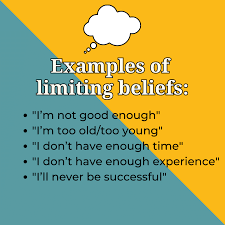
Defining limiting thoughts and beliefs:
Limiting beliefs are a set of self-imposed restrictions and false assumptions about ourselves, our potential, and the world around us. They can hold us back from achieving success, reaching our goals, and living life to its fullest.
Where do limiting thoughts come from? They may have been instilled in us by our family, by those we have surrounded ourselves with or even ourselves. We may have failed at something in our life and as a result, continued to believe we will continue to fail.
Regardless of their origin, they can have a powerful effect on how we see and experience the world. They can leave us with feelings of fear, inadequacy, and self-doubt that impede our progress in all parts of our life.
Often, we spend time trying to unpack and understand the origin of our thoughts and feelings. The process of discovery can be valuable, however continuing to look back can keep us focused on the past and not taking the action steps to move forward.
Examples of limiting thoughts and beliefs

Identify what your limiting thoughts and beliefs are:
“I’m too old or too young for that.”
“I’m not capable of completing this goal”
“I will spend my whole life alone.”
“I’ll never find a job that brings me happiness. It’s just a job.”
“I will never be able to do that.”
Steps to overcoming limiting thoughts and beliefs
1. Identify one of your limiting beliefs
The first step to overcoming your limited beliefs is to identify what they are. If you fear there may be multiple limitations, then start with the largest one and then repeat this step with each limiting belief.
2. Recognize that it is just a belief
Recognize that your belief may simply be a belief founded on falsities. It is likely to be completely untrue and is just a belief, not a fact.
3. Challenge your own belief
Now that you have recognized it is just a belief, rather than a grounded fact, question your belief. Question it by raising such questions as:
• Is this belief really grounded? What are the supporting facts? • Did I always think that way? If not, what has changed? • Is there evidence counteracting my belief? • What would it be like to think of the opposites to my belief? • Is this belief helping me to progress towards my goals? • How would I think about this belief if I were someone else (Eg. a successful CEO, a medical professional, a famous author, etc.)?
Asking yourself these questions can help you to broaden your perspective on the subject and help encourage ‘outside the box’ thinking. When arguing against your own initial thinking, you may realize that it is not quite what you were thinking which can lead you to change your thinking to something more positive and encouraging.
4. Recognize the potentially damaging consequences
What are the consequences of holding on to your limiting belief? Holding on to the belief that you are not able to do something because you failed your first attempt can deprive you of accomplishing in the future and have the desired outcomes you are looking for.
5. Adopt a new belief
Choose something new to believe in, something that will help to improve your life. This transition may not be easy. Depending on how long you have thought and lived through what led you to believe what you believe, it may have created an extraordinarily strong emotional bond and rooted the belief very strongly. If you want to change you will need to have the strength and courage to make that change in thinking and adopt the new belief.
Committing to daily journaling, sharing with a trusted friend or guide, putting up notes in areas you visit regularly, listening to empowering podcasts and meditating about the new belief can all be powerful tools to create a new belief.
6. Put it into practice
Take action and start implementing things that support your new belief. If your limiting belief told you that you were “too old to start exercising”, instead start to adopt an “It is never too late to start” belief and then, today, go for a 15-minute walk to start exercising and create a habit from there.
Conditioning yourself to your new beliefs means creating the reality you want for yourself in your mind, visualizing the results you want to achieve. Visualization is a great way to create anticipation. You will mentally experience result you want to achieve. With this, you will be sending congruent signals to your brain, making it work for you.
In Conclusion:
All human beings have limiting thoughts and beliefs, therefore it’s important not to beat yourself up that you are working to better understand this area of your life. We have countless influences throughout life, some are great, and it’s imperative to give credit to those great influences. Like any other change we are wishing to accomplish in life, it takes practice and consistency. The outcomes will appear as you push through your barriers and feel a huge sense of accomplishment and then feel driven to complete the next goal. If you are looking to improve and feeling stuck or need some support and guidance, contact me at 440-212-4987 for a free 15 minute coaching session. Now, get out there and slay some dragons!
